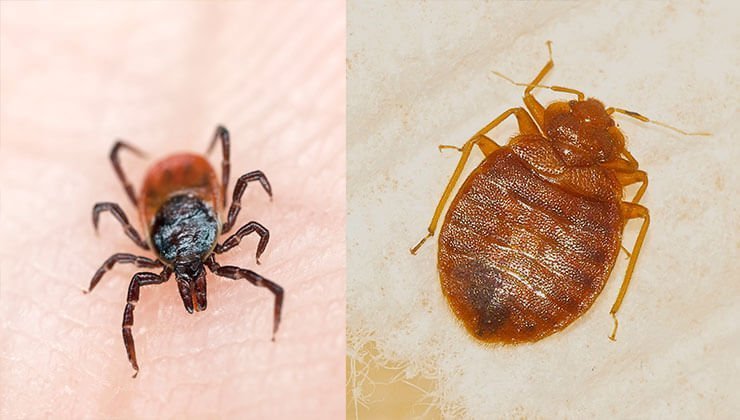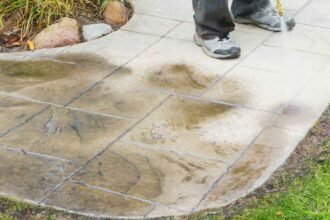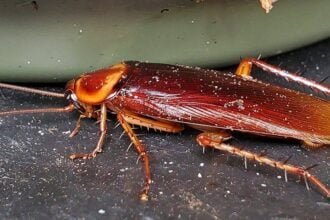Both ticks and bed bugs have the same impact on humans, which is to cause them to feel repulsed and repelled by the creatures. When you think about these animals that feed on blood, it’s enough to make your skin crawl simply thinking about them. On the other hand, this is where the similarities end. Ticks and bed bugs are not the same thing in a number of significant ways.
Continue reading if you are interested in learning how to differentiate between them and the differences that exist between them. Even while you probably won’t see a battle between ticks and bed bugs in real life, it is still extremely important to be aware of the differences between the two and, more importantly, how to avoid being bitten by either of them.
1. Bed bugs have six legs, and tick eight.
The term “bug” is technically reserved for insects with specialized sucking mouthparts. Bed bugs, aphids, leafhoppers, and tens of thousands of other insect species feed on plant fluids (Cimex lectularius). Bed bugs have six legs on their thorax or trunk.
Ticks are arachnids, not insects. Incorporate spiders, scorpions, and mites. Each of an arachnid’s eight legs is attached to its cephalothorax. Ixodidae (hard tick) is the deadliest tick family.
2. Ticks prefer the outdoors, whereas bed bugs prefer the sheets
Bed bugs and ticks can’t fly or jump, thus infections happen when a host is close enough. Bed bugs live in mattresses and other soft furnishings, waiting for a passing host. They can even crawl through the carpet, which is ideal for laying eggs because to its warm, humid conditions. Bed bugs are most common in infested hotels, but they’ll go with you in your luggage.
Ticks prefer to hide in tall grass, heaps of leaves, or other outdoor forested areas until a warm-blooded animal approaches. They won’t penetrate your home without work.
3. Ticks spread disease, unlike bed bugs.
Although bed bugs can carry many illnesses, there is no evidence they can infect humans. Scratching bed bug bites might transmit germs.
Tick bites deliver harmful viruses and germs to people and other animals. Lyme disease is the most common, especially in the Midwest and Northeast. Other tick-transmitted diseases include tularemia, anaplasmosis, Rocky Mountain spotted fever, and ehrlichiosis.
4. Ticks prefer animals to humans, whereas bed bugs prefer blood.
Ticks and bed bugs feed on human blood despite their distinctions. Ticks feed on warm-blooded animals, unlike bed bugs. If their preferred host isn’t present, both bugs will cheerfully swallow the other blood. Ticks prefer deer, dogs, rodents, or birds as hosts, but will bite humans if they can’t. Bed bugs feed on dogs, cats, and other mammals.
5. The size difference between a tick and a bed bug is substantial.
Ticks and bedbugs share an oval form, no wings, and flat bodies. But there are distinguishing features. Bed bugs are reddish brown, while ticks have lighter bodies and striped legs. Ticks’ bodies swell after a meal. Bed bugs expand when they feed on blood, albeit less dramatically than other insects. Bed bugs are bigger than ticks, despite their comparable size. A typical hard tick is the size of a sesame seed before it has eaten, compared to an 8-millimeter bed bug.
6. Comparatively, ticks only bite once, whereas bed bugs might bite several times in a single night.
Tick and bed bug bites can create itchy, swelling bumps, but they feed and bite differently. During feeding, a tick clings to the skin and buries its head. They can bite anywhere on the body but prefer the groin or armpit. Depending on the host, a tick can feed for days. After disengaging, the tick falls off.
Bed bugs feed while perched on skin. Tube-like mouths pierce the skin to draw blood. After eating, they leave or move to a new area to repeat. Bed bugs can attack unprotected skin anywhere. Most infections occur on the ankles, chest, arms, hands, neck, and face.
Hire a Pest Control Expert
Get free, no-obligation quotes from local, fully-insured pest control pros.
How do I prevent being bitten by bed bugs while I’m sleeping?
Declutter
Bed bugs have a propensity for clustering in limited areas that are also dark and lacking in humidity. For this reason, it always seems that the most attention and use are focused on beds and mattresses in residential and hospitality contexts. If you clean out your closets and look behind your cabinets, there will be fewer locations in your home where these people can hide.
Avoid Sharing Closet
Even if you take every effort to keep bed bugs out of your closet, they may still make their way in if you share a closet with other people at home or at the office. This is especially true if you keep your clothes in the closet rather than on the floor. The more likely scenario is that the person brought them home in a coat or some other article of clothing.
Perform regular checks for pests
It is possible to prevent bed bugs from ever becoming a problem by adopting preventative steps such as checking for their existence on a regular basis and washing and hand-vacuuming any cushions, bedding, and furniture. However, expert warns that there are some instances in which the intervention of a skilled professional is required in order to completely remove the infestation.
Note any possible bedbug hotspots
If you find any evidence of bed bugs in a particular room, make a note of it so that you can be especially vigilant in that particular space. It’s possible for bed bugs to rear their ugly heads multiple times inside the same location.
Is there a foolproof method to eliminate bedbugs from my abode?
It is not unusual to have an experience with bedbugs. It’s possible that you’re having problems but are utterly oblivious to the fact that you are. However, once they have established themselves in your home, it is probable that they cannot be eradicated completely. Either you may do it yourself using some natural ways, or you can call in an exterminator that is trained and experienced in the field. There are a number of obvious symptoms that can be used to identify bed bugs, including an unpleasant musty odor, feces or blood stains on your sheets or mattress, and the shedding of bed bug skin.
Clean the house from top to bottom, including the bedding. Please vacuum and mop. Wash any clothing that may have come in contact with the insects. To kill them, wash everything in the house.
- Put uncleanable plastic containers away for later. Without food, bed bugs on these items won’t last long.
- Bed bugs and eggs hate heat and humidity. Get a handheld steamer to kill home-infesting insects. To be effective, steam must be at least 160°F. Spray the walls, furniture cracks, mattress, and other hiding spots.
- Trim and drywall are everywhere. Flatbed bugs can hide in tight places.
- Use diatomaceous earth powder. Humans, animals, and linens are safe. This powder’s effects on bed bugs aren’t fast, but they’ll last as long as you sprinkle it on your mattress and baseboards. To prevent inhalation, wear a mask when spreading this powder.
- Hire experts now. High temperatures can kill bedbugs in a home. Bed bugs and eggs can be eliminated swiftly and permanently with one treatment of 130-degree heat.







